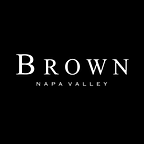PLACE MATTERS
There’s More To Brown Estate Than Meets The Eye
{Spring 2011}
The photo above features our easternmost cabernet sauvignon vineyard, situated in an amphitheater of oak trees at an elevation of 1450 feet, with morning fog lifting at 11:30am. Somewhere in the vicinity of this vineyard dwells “our” black bear, who in the course of his travels helps himself liberally to our cabernet sauvignon grapes. (Important to note is the fact that we believe he eschews the zinfandel only because it’s too far away from his lair.) Occasionally he deposits his scat in the middle of the road to let us know he’s been there, and no doubt to remind us that he will carry on doing as he pleases. Who are we to argue?
At the macro level, the most unique characteristic of the Brown Estate property is that our fifty acres of vineyards are planted amidst 450 acres of roughneck wilderness, all of which are under our exclusive control — with deference, of course, to Mother Nature. As BE winegrower Dave Brown puts it, “The fact that our vineyards comprise only ten percent of our land really gives you the sense that the vineyards are part of a larger organism. The surrounding woods are a constant reminder that the land belongs less to us than to the animal and plant life we share it with.”
At the micro level, very specific climatic phenomena come into play that are as persistent and unique — and nearly as tangible — as the topography itself. By all accounts, terroir — that mystical amalgamation of climate, exposure to sunlight, topography, geology, and hydrology — is a misunderstood concept, not least because the implication that something magical can derive from the place where wine grapes are grown makes the term itself ripe, if you will, for misuse. However, our experience residing and farming grapes on our Chiles Valley property over the last three decades confirms that in our far-flung corner of the Napa Valley, the dynamics of terroir are in full effect. Part of the inherent joy in producing estate wines is that year in and year out we see the DNA of place imprinted into the flavor profiles of the wines we bottle, no matter how dramatically the growing seasons or the vintages themselves may differ. These indelible characteristics comprise what we consider to be an unmistakable Brown Estate pedigree — the direct result of our unique terroir.
MICROCLIMATE
Our microclimate may be the most remarkable feature of our property from a winegrowing perspective. In our location at the southeast end of the Chiles Valley, the channeling of the prevailing northwesterly wind is especially pronounced. From the western edge of our property to the easternmost ridge, this wind pattern couples with an increase in elevation and a subsequent drop-off opening into adjacent Capell Valley that creates a noticeable Venturi effect. The result is a dramatic cooling that tends to coincide with peak daytime temperatures in the late afternoon on warm summer days. For thirty years we have observed this Venturi pulling moist air from San Pablo Bay that in turn pushes up through Napa against Atlas Peak just to the south, resulting in the fog that so often settles on our property. Even when this fog does not form, historical data from our weather monitoring system reveal that humidity levels on our property routinely reach 99 percent by dawn, even during the warmest part of the summer. While this phenomenon may not be singular to the Chiles Valley, at Brown Estate it is especially dramatic. Finding ways to express the uniqueness of our microclimate with integrity and an overall sense of purity has become our winegrowing mission.
TOPOGRAPHY
No less extraordinary than the meteorological forces at work is the drama of the topography itself. In Dave’s estimation, this may be the most valuable attribute derived from farming in the mountains. The diversity of terrain across our property currently accommodates nine geographically isolated vineyard blocks that vary in all aspects — elevation, soils, exposure, etc. The rugged topography of our land as a whole intensifies the interaction with weather patterns and distinguishes each of our nine vineyard blocks, despite their close proximity. Moreover, the diverse and mountainous terrain of Brown Estate yields abundant water resources thanks to the presence of seven natural springs and significant catchment acreage.
BROTHER NATURE
The most ideal growing conditions on Earth mean nothing without best farming practices. During a recent conversation about jazz music and wine, Dave explained that as both farmer and winemaker, “unpredictability forces you to improvise, because you never know what to expect.” Over the last thirty years, our family has cultivated an intimate knowledge of this place. This relationship gives Dave a decided leg up in his collaborative partnership with Mother Nature, which depends as much upon his ability to finesse her whims as it does upon what she serves up each growing season. As he puts it, “You have to know when to intervene, and have the confidence to trust that sometimes hands-off is the best approach. Being able to relinquish control is a luxury made possible by heightened situational awareness.” This awareness is born of a spirit of adventure and a willingness to experiment. “If you don’t take anything for granted,” Dave says, “if you question everything, the process is one of pure discovery. By engaging in continued inquiry and investigation, you learn things you simply wouldn’t if you presumed to have all the answers already.”
In many ways, this philosophy applies to the Brown Estate project as a whole. We came into this business rather by accident, taking nothing for granted and with tremendous humility. Both the wine industry and Mother Nature are forces to be reckoned with, and our journey has been and remains one of endless discovery.
Originally published in our quarterly newsletter, The BE Paper, Spring 2011. To see/download full issue, click here. {Photos by Carolyn Corley Burgess.}
